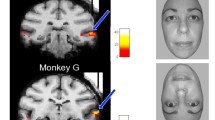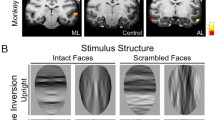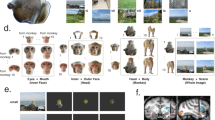Abstract
Neurons in the temporal visual cortical areas of primates have large receptive fields, which can show considerable selectivity for what the stimulus is irrespective of exactly where it is in the visual field. This is called translation invariance. However, such results have been found when there is only one stimulus in the visual field. The question arises of how the visual system operates in a cluttered environment. To investigate this we measured the responses of neurons with face-selective responses in the cortex in the anterior part of the superior temporal sulcus of rhesus macaques performing a visual fixation task. We found that the response of neurons to an effective face centred 8.5° from the fovea was decreased to 71% if an ineffective face stimulus for that cell was present at the fovea. In a similar way, introduction of a parafoveal ineffective face stimulus decreased the responses of these neurons to an effective face stimulus at the fovea to 75%. In addition to these interactions, it was found that an effective stimulus object at the fovea produced a larger response than when it was parafoveal, and that this weighting towards an object at the fovea was also seen when more than one object was present in the visual field. The implication of this weighting of the responses of neurons towards objects at the fovea, even in an environment with more than one object present, is that the output of the visual system provides information to subsequent systems particularly about objects at the fovea, so that learning about these objects (and less about other objects elsewhere in the visual field) is facilitated.
Similar content being viewed by others
References
Ballard DH (1993) Subsymbolic modelling of hand-eye co-ordination. In: Broadbent DE (ed) The simulation of human intelligence. Blackwell, Oxford, pp 71–102
Baylis GC, Rolls ET, Leonard CM (1985) Selectivity between faces in the responses of a population of neurons in the cortex in the superior temporal sulcus of the monkey. Brain Res 342:91–102
Cowey A, Rolls ET (1975) Human cortical magnification factor and its relation to visual acuity. Exp Brain Res 21:447–454
Desimone R, Gross CG (1979) Visual areas in the temporal cortex of the macaque. Brain Research 178:363–380
Desimone R (1991) Face-selective cells in the temporal cortex of monkeys. J Cog Neurosci 3:1–8
Feigenbaum JD, Rolls ET (1991) Allocentric and egocentric spatial information processing in the hippocampal formation of the behaving primate. Psychobiology 19:21–40
Gaffan D, Harrison S and Gaffan EA (1986) Visual identification following inferotemporal ablation in the monkey. Quart J Exp. Psychol 30B:5–30
Gross CG, Rocha-Miranda CE, Bender DB (1972) Visual properties of neurons in inferotemporal cortex of the macaque. J Neurophysiol 35:96–111
Gross CG, Mishkin M (1977) The neural basis of stimulus equivalence across retinal translation. In Lateralization in the Nervous System (eds. Harnad S, Doty R, Jaynes J, Goldstein L and G. krauthamer), pp 109–122. New York: Academic Press
Hasselmo ME, Rolls ET, Baylis GC, Nalwa V (1989) Objectcentered encoding by face-selective neurons in the cortex in the superior temporal sulcus of the monkey. Exp Brain Res 75:417–429
Judge SJ, Richmond BJ, Chu FC (1980) Implantation of magnetic search coils for measurement of eye position: an improved method. Vision Res 20:535–538
Leonard CM, Rolls ET, Wilson FAW Baylis GC (1985) Neurons in the amygdala of the monkey with responses selective for faces. Behav Brain Res 15:159–176
Malsburg C von der (1990) A neural architecture for the representation of scenes. In: McGaugh JL, Weinberger NM, Lynch G (eds) Brain organization and memory: cells, systems and circuits. Oxford University Press, New York, pp 356–372
Merrill EG, Ainsworth A (1972) Glass-coated platinum-plated tungsten microelectrodes. Med Biol Eng 10:662–672
Miller EK, Gochin PM, Gross CG (1993) Suppression of visual responses of neurons in inferior temporal cortex of the awake macaque by addition of a second stimulus. Brain Res 616:25–29
Mishkin M, Lewis ME, Ungerleider LG (1982) The equivalence of parietopreoccipitial subareas for visuospatial ability in monkeys. Behav Brain Res 6:57–77
Mishkin M, Ungerleider LG, Macko KA (1983) Object vision and spatial vision: Two cortical pathways. Trends Neurosci 6:414–417
Moran J, Desimone R (1985) Selective attention gates visual processing in the extrastriate cortex. Science 229:782–784
Perrett DI, Rolls ET, Caan W (1982) Visual neurons responsive to faces in the monkey temporal cortex. Exp Brain Res 47:329–342
Richmond BJ, Wurtz RH, Sato T (1983) Visual responses of inferior temporal neurons in the awake rhesus monkey. J Neurophysiol 50:1415–1432
Rolls ET (1984) Neurons in the cortex of the temporal lobe and in the amygdala of the monkey with responses selective for faces. Human Neurobiol 3:209–222
Rolls ET (1990) A theory of emotion, and its application to understanding the neural basis of emotion. Cogn Emot 4:161–190
Rolls ET (1991) Neural organisation of higher visual functions. Curr Opin Neurobiol 1:274–278
Rolls ET (1992a) Neurophysiological mechanisms underlying face processing within and beyond the temporal cortical visual areas. Philos Trans R Soc Lond Biol 335:11–21
Rolls ET (1992b) Neurophysiology and functions of the primate amygdala. In: Aggleton JP (ed) The amygdala. Wiley-Liss, New York, pp 143–165
Rolls ET (1992c) The processing of face information in the primate temporal lobe. In: Bruce V, Burton M (eds) Processing images of faces. Ablex, Norwood, NJ pp 41–68
Rolls ET (1994a) Brain mechanisms for invariant visual recognition and learning. Behav Proc (in press)
Rolls ET (1994b) Learning mechanisms in the temporal lobe visual cortex. Behav Brain Res (in press)
Rolls ET, Baylis GC (1986) Size and contrast have only small effects on the responses to faces of neurons in the cortex of the superior temporal sulcus of the monkey. Exp Brain Res 65:38–48
Rolls ET, Cowey A (1970) Topography of the retina and striate cortex and its relationship to visual acuity in rhesus monkeys and squirrel monkeys. Exp Brain Res 10:298–310
Rolls ET, Tovee MJ (1994) Processing speed in the cerebral cortex and the neurophysiology of visual masking. Proc R Soc Lond [B] 257:9–15
Rolls ET, Burton MJ, Mora F (1976) Hypothalamic neuronal responses associated with the sight of food. Brain Res 111:53–66
Rolls ET, Sanghera MK, Roper-Hall A (1979) The latency of activation of neurons in the lateral hypothalamus and substantia innominata during feeding in the monkey. Brain Res 164:121–135
Rolls ET, Tovee MJ, Purcell DG, Stewart AL, Azzopardi P (1994) The responses of neurons in the temporal cortex of primates, and face identification and detection. Exp Brain Res 101:474–484
Rolls ET, Yaxley S, Sienkiewicz ZJ (1990) Gustatory responses of single neurons in the orbitofrontal cortex of the macaque monkey. J Neurophysiol 64:1055–1066
Rolls ET, Hornak J, Wade D, McGrath J (1994) Emotion-related learning in patients with social and emotional changes associated with frontal lobe damage. J Neurol, Neurosurg and Psychiat 57:1518–1524
Rolls ET, Tovee MJ, Purcell DG, Stewart AL, Azzopardi P (1994a) The responses of neurons in the temporal cortex of primates, and face identification and detection. Exp Brain Res 101:474–484
Rolls ET, Hornak J, Wade D, McGrath J (1994b) Emotion-related learning in patients with social and emotional changes associated with frontal lobe damage. J Neurol Neurosurg Psychiatr 57:1518–1524
Sary G, Vogel R, Orban GA (1993) Cue-invariant shape selectivity of macaque inferior temporal neurons. Science 260:995–997
Sato T (1988) Effects of attention and stimulus interaction on visual responses of inferior temporal neurons in macaque. J Neurophysiol 60:344–364
Sato T (1989) Interactions of visual stimuli in the receptive fields of inferior temporal neurons in awake macaques. Exp Brain Res 77:23–30
Tovee MJ, Rolls ET (1992) Oscillatory activity is not evident in the primate temporal visual cortex with static stimuli. Neuroreport 3:369–372
Tovee MJ, Rolls ET (1993) The temporal responses of translation invariance neurons in the primate temporal visual cortex. Perception 22:141
Tovee MJ, Rolls ET, Treves A, Bellis RP (1993) Information encoding and the responses of single neurons in the primate temporal visual cortex. J Neurophysiol 70:640–654
Tovee MJ, Rolls ET, Azzopardi P (1994) Translation invariance in the responses of single neurons in the temporal visual cortical areas of the alert macaque. J Neurophysiol 72:1049–1060
Treves A, Rolls ET (1994) A computational analysis of the role of the hippocampus in nemory. Hippocampus 4:1–18
Wallis G, Rolls ET, Foldiak P (1993) Learning invariant responses to the natural transformations of objects. International Joint Conference on Neural Networks 2:1087–1090
Weiskrantz L, Saunders RC (1984) Impairments of visual object transforms in monkeys. Brain 107:1033–1072
Author information
Authors and Affiliations
Rights and permissions
About this article
Cite this article
Rolls, E.T., Tovee, M.J. The responses of single neurons in the temporal visual cortical areas of the macaque when more than one stimulus is present in the receptive field. Exp Brain Res 103, 409–420 (1995). https://doi.org/10.1007/BF00241500
Received:
Accepted:
Issue Date:
DOI: https://doi.org/10.1007/BF00241500




